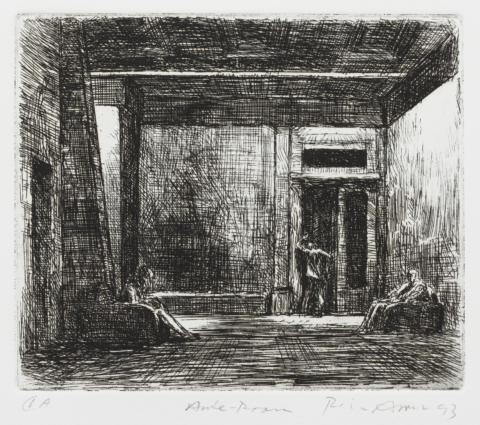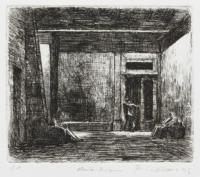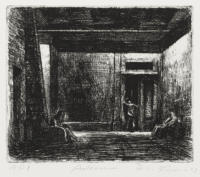
Etching. In a large anteroom with a high, coffered ceiling, and with concealed lighting around the walls, a man and a woman sit in armchairs; they sit opposite one another but on different planes. The woman, who is seated on the left, looks down, her hair covering her profile. At the far end of the room a besuited man, his back to the viewer, stands in a doorway, leaning against the jamb to his left, his left arm raised to support him. The etched line is comparatively thin but the subject is substantially complete in its detail. There are three variant impressions of this state.
The woman’s legs have been covered with cross-hatching.
- Catalogue Number
- E.076
- Title and Date
- Ante-room 1993
- Description of Featured Image
- In a large anteroom with a high, coffered ceiling, and with concealed lighting around the walls, a man and a woman sit in armchairs; they sit opposite one another but on different planes. The woman, who is seated on the left, looks down, her hair covering her profile. At the far end of the room a besuited man, his back to the viewer, stands in a doorway, leaning against the jamb to his left, his left arm raised to support him.
- Where Made
- Dunmoochin, Cottles Bridge
- Medium Category and Technique
- Intaglio Print: Etching and burnishing on copper
- Support
- Wove paper. Identified papers: Arches paper with watermark: ‘ARCHES / FRANCE’ with infinity symbol.
- Dimensions
-
Image size: 147 x 175 mm
Matrix size: 151 x 177 mm - Artist’s Record Number
- RAE.71
- Printer(s) and Workshop(s)
- All impressions printed by Rick Amor in his Dunmoochin studio, Cottles Bridge.
- Summary Edition Information
- Five states. Nominal edition of ten, but only four impressions printed and numbered, 1993.
- Literature
- For an illustration of the painting Study for ‘The ante-room’, 1993, see Niagara Galleries, Rick Amor (exh. cat.), Niagara Galleries, Richmond, Victoria, 1994, cat. no. 6.
- For a general discussion of Amor’s narrative subjects, including the anteroom works, see Chris Wallace-Crabbe, ‘Painting in a Dangerous Area’, Art Monthly (Australia), November 1995, pp. 10–11.
- Gary Catalano, The Solitary Watcher: Rick Amor and His Art, Melbourne University Press, Carlton South, Victoria, 2001, pp. 149–50.
- Collections
- State Library of Victoria, Melbourne: six state impressions, numbered 1A, 1B, 1C, 2, 3, 4; ed. 4/10.
- National Gallery of Australia, Canberra: ed. 1/10, on cream paper, as Anteroom (2007.602).
- Comment
This etching is one of several closely related painted and etched works, in which the interiors combine architectural elements drawn from several buildings. The setting here is based on the upstairs foyer of the Astor Theatre, an Art Deco cinema (built 1935–36) in the inner Melbourne suburb of St Kilda. E.076 is otherwise modelled, though with the orientation reversed, on Study for ‘The ante-room’, painted in June–July 1993 (Niagara Galleries 1994).
Ante-room itself became the model for another etching, with the same title, made in 1996 and reworked in 1999 and 2002 (cat. no. E.102). The 1996 composition is in reverse orientation to that of E.076, and is etched on a larger plate. There is also a difference in the positioning of the seated figures in the two etchings: in E.076, the figures are situated further back than in E.102. As a result, the room has a different sense of internal scale and spatial recession in the two works.
The enigmatic narrative of E.076 was inspired by a literary source – T. S. Eliot’s poem ‘Sweeney among the Nightingales’ (1918). In making this print, Amor responded to Eliot’s richly allusive and pessimistic text, with its references to silent men and muffled, indistinct conversations.
Amor has long read Eliot’s poetry and often goes to it for inspiration for his titles and imagery. The artist also appreciates what he describes as Eliot’s ‘dry and flat speaking voice’, a voice Amor was familiar with from cassette tapes that he owned, and whose vocal character seemed to him to match the visual character of his own images. In the case of his anteroom subjects, Amor points also to another source: he has linked the uneasy narratives of these works to the moody and surreal cinematic narratives of David Lynch, whose films he admires.
Amor’s development of this etching over five states was concerned principally with the manipulation of light, and with its effects on perceptions of space and of emotional aura.
The treatment of ‘anteroom’ in the titles inscribed on the various impressions of E.076 varies.
- Keywords
- Figures, Interior
- URL
- https://catalogue.rickamor.com.au/works/intaglio/ante-room-2/
Record last updated 15/02/2021


